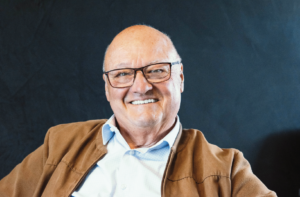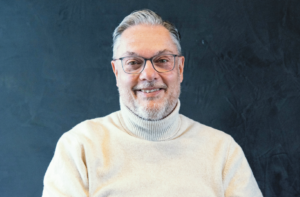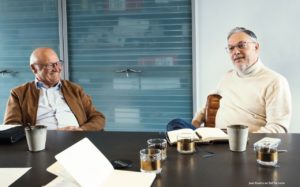
29 Jun What does the board say? (Jun ’23)
‘DADDY KATE HAS THE RIGHT MENTALITY TO GO ON FOR A LONG TIME’
Reculer pour mieux sauter, says the French proverb. Jumping has been done by the Daddy Kate Group for several years now, together with its partner companies. But to jump thoughtfully, it is good to have someone beside you to show the blind spots. That task falls to the board of directors. How do they look at Daddy Kate today? And how do they see the group continuing to evolve? A conversation with former chairman Jean Dooms and current chairman Stef De corte.
GENTLEMEN, HOW DID YOU END UP ON THE BOARD OF DADDY KATE?
Jean Dooms: ‘I was already on the advisory board of Claes-Roels Printing in 2012. But that was rather a non-committal role. However, after the merger with The Factory Brussels – the former Arteprint – in 2015, Thijs wanted a more formal body. And so there was an official board of directors, with a family branch and two external advisers. That was Stef and me.
Stef De corte: “Right. Indeed, I only joined later, in 2016. That was actually quite funny, because it was the very first time in my career that I had to apply for a position. Thijs and Guido Geraerts, the former manager of The Factory Brussels, sat at one of those black bars and asked all kinds of questions. I had never had to do anything like that before. But my added value must have convinced them anyway, because I have been on the board of directors for seven years now.’
SO WHAT DO YOU THINK IS YOUR ADDED VALUE?
SDC: ‘We do have some kilometres on the clock in the meantime. Jean in the paper sector, I at Smartphoto. When you then see such a young CEO as Thijs at the helm, you still want to share your experience and make sure he doesn’t make the mistakes we have already made in the past.’
JD: ‘Stef is more dominant than me in that respect. I want to be more of a facilitator to achieve a good result. At Daddy Kate, I am now mainly involved in guiding acquisitions. With my experience, that is also my strength. When I was still working as managing director at Antalis and Igepa, I also successfully completed some acquisitions.’
CAN YOU GIVE A CONCRETE EXAMPLE OF YOUR ROLE ON THE BOARD OF DIRECTORS?
SDC: ‘Yes. Jean will not be quick to say it himself, but the acquisitions in France are largely to his credit. Those were difficult talks that dragged on for a year. Bruno and Thijs even wanted to give up at one point, but Jean persevered.’
JD: ‘That’s the advantage of having an external role, of course. I am not the shareholder who comes to take over the company. I can gain the trust of the other party. And then a conversation like that is also much more open than when you only have the acquirers sitting in front of you. Then you really don’t find out everything. If I can come to an agreement after a long talk, it gives me great satisfaction. ‘For example, I never wanted a contract with Daddy Kate either. So our relationship was also based on trust. If I no longer added value, they had to tell me immediately. And conversely, I would also quit if I felt I could no longer contribute anything.’
SDC: ‘You also have to dare to play devil’s advocate as a board. Have you thought about that? What do you do if this or that happens? Every company has blind spots. So does Daddy Kate. Our job as advisers is to point them out to Thijs. For instance, he didn’t see the added value of those printing companies in France, and still had some cold feet. It took at least two years before he understood what a positive effect it would have on volume at Daddy Kate. It is also thanks to Jean’s work that Thijs changed his mind. But Thijs is very conscious of that today. I think that’s also the role we have to play. Ensuring that Daddy Kate actually sees the opportunities that are there.
“There are few printing companies that do not come and talk to Thijs when they want to hand over their business”- Jean Dooms
WHAT MAKES DADDY KATE UNIQUE TODAY?
JD: ‘First and foremost, the family shareholding and the youthful management. Thijs is the leader, yet his way of managing is mainly participative. He is motivating and innovative. And he has the vision to diversify. Surely, in a declining market, that determines Daddy Kate’s success.’
SDC: ‘That decline is indeed much less present at Daddy Kate. I think the key is their focus on customers. In other companies, they focus more on growth, price and winning bids. Daddy Kate does not easily tell customers not to do something. They can do that because of their diverse offering. And you can also see that customers are loyal as a result. Despite the fact that Daddy Kate is still top three in Belgium, I really like the small-scale spirit. Just doing what you have to do, don’t start hovering and feet on the ground.’
JD: ‘They also have that image to the outside world and that creates a certain appeal. There are few companies that don’t come and talk to Thijs when they want to hand over their business. Daddy Kate is the first one they think of.’
SDC: ‘The market knows Daddy Kate’s philosophy. In fact, I think printers would have waited longer to sell if Daddy Kate hadn’t existed. And that is never good news, because then it might be too late and the customers will be gone. They see with Thijs that the synergy works. The acquired companies still retain their individuality. Those are stories that circulate and that allows Daddy Kate to choose which parties it will partner with.’

HOW HAVE YOU SEEN DADDY KATE DEVELOPING OVER THE YEARS?
JD: ‘It wasn’t always sunshine and rainbows. Fortunately, Thijs quickly realized that digital printing and visual communication was the future. Diversifying was and is the right direction.’
SDC: ‘It is in that context that the acquisitions in Belgium also took place. That commercial synergy was important to expand the offering to existing customers. In France, it was more about an operational choice. To increase volume.’
JD: ‘Offset is not dead either, of course. But you have to maintain volume to make your machines work. If the market is not growing, you have to get that volume in another way. That’s why these acquisitions are so important for Daddy Kate.’
SDC: ‘I think Thijs has also mainly learned in recent years that having two shareholding branches sometimes slows things down. The sector changes so quickly that you also have to change gear quickly. Thijs wants to stay in that driver’s seat. By taking over the Geraerts family’s shares in The Factory Brussels, Thijs was able to regain the full lead. That acceleration has brought Daddy Kate to where it is today. A clear vision around acquisitions has also been developed. What do we want? What do we not want? There are still many opportunities on the table today and that is the homework Thijs gives the board of directors. How can we put the puzzle together even better? It is up to us to help brainstorm on that list of opportunities’.
HOW DO YOU SEE THE SYNERGIES IN THE GROUP?
SDC: ‘There are agreements, of course. If you sell offset, it makes sense for it to go to Daddy Kate, for instance. And the different companies also look at each other’s customers. There might be a sister company that has been wanting to get in somewhere for years. If that customer is then in the portfolio of another company in the group, the step is smaller. So it is an active process. They shouldn’t wait for it to fall out of the sky.’
JD: ‘That cross-selling has to be there, of course. Publi-FDM customers used not to be able to get printed matter on paper, even though they often needed it. Now they can. And conversely, Daddy Kate’s customers can now order signage, for example.’
WHAT DO YOU THINK ARE THE MAIN CHALLENGES FOR THE COMING YEARS?
SDC: ‘Well, the group has grown big. You have to manage all that well. Everyone is working really hard now, and is in a kind of honeymoon period because of these acquisitions. Business is good and all employees are happy. That automatically creates a good flow. But at some point you have to start developing good management. At the moment, too much falls on Thijs’ shoulders. HR and Finance also need to set up a good structure.
JD: ‘Indeed, for me it’s about finding the ideal structure, the ideal organisation and the ideal management. Do you go to one big company? Do you go to one company per activity? Do you stay in one location? These are all questions you have to think about in the future.’
SDC: ‘Creating that awareness is important. When you work day in, day out, you don’t always think about it. As a board, we don’t have the solutions, but we can encourage people to think about them. Jean sometimes dares to push where it hurts. Thijs doesn’t find that pleasant, but he realizes that he needs that from time to time.’
HOW DO YOU SEE DADDY KATE’S FUTURE?
JD: ‘There are still opportunities, for example in the packaging sector. Packaging used to be a means of transport. Now it is a means of communication. Moreover, you need more packaging because of e-commerce. So I think there is still a future for offset here.’
SDC: ‘Also for digital printing. Shopwedo from Mechelen, for example, is one such company that makes and ships packaging for e-commerce. The chocolates from Neuhaus are just there with them. Then, when an order comes in on Neuhaus’ platform, they do the rest. They create and print the customized packaging, with a personalized message on it. Then they ship it directly to the customer. This customized printed packaging does represent a trend. Air transport is not ecological and besides, postal companies start charging surcharges if your parcel is too big.’
“As a board we don’t have the solutions, but we can encourage thinking about those solutions” – Stef De corte
SDC: ‘In addition, I think anything to do with direct communication in people’s homes also has a future again. It was supposedly doomed by digitalization, but in fact these are ephemeral media. People still like to hold something in their hands. This is another area where there are still opportunities for Daddy Kate.
IN CONCLUSION, THIJS SOMETIMES SAYS THAT HE WANTS TO BUILD A COMPANY THAT WILL STILL BE THERE IN A HUNDRED YEARS’ TIME. IS THAT A REALISTIC WISH IN THIS SECTOR?
JD: ‘Well, at least the right mindset is there to continue for a long time, but what the world will look like in 20 years, no one can predict.’
SDC: ‘Companies are always going to keep communicating. So carriers will continue to be needed. We can discuss that every six months, but the answer will always be the same. So I do believe in it. Above all, Daddy Kate has to make sure it remains agile. If you keep doing everything routine, you haven’t seen the world change around you. They need to keep listening to customers and make sure they can answer their questions. Combine that with a good management team and then I think Daddy Kate has little to worry about. Thijs knows he needs to think broader than Thijs. And he is also making it work. I think in the short term that is the most important thing that needs to happen.’

WHO’S JEAN DOOMS?
◉ Served on the advisory board of Claes-Roels Printing from 2012 to 2015. Then became chairman of the board of directors of the new Daddy Kate. Quit that position in July 2020 and since then still plays an active role in acquisitions and new opportunities.
◉ Started working in the insurance sector after studying technical science engineering.
◉ Worked for twenty years at Antalis, the largest European distributor of paper, packaging and materials for visual communication. Became managing director there in 1990.
◉ Joined competitor Igepa Belux as managing director in 2000.

WHO’S STEF DE CORTE?
◉ Has served on Daddy Kate’s board of directors since 2016. Has been chairman there since July 2020.
◉ Started as a civil engineer at LMS International – later acquired by Siemens -, Bekaert and ABB Services.
◉ Joined Spector Photo Group as CFO in 1999. Became CEO there in 2005 and remains so today.
◉ Supervised the successful transition to today’s Smartphoto Group in 2011, and is one of the driving forces behind the listed company’s success.
Source: Daddy Kate Yearbook ’22





Sorry, the comment form is closed at this time.